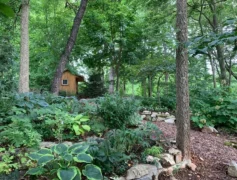
Understanding plant tags: light, zones, natives and more
Understanding plant tags: light, zones, natives and more
Thanks to the University of Maryland/Maryland Grows this informative article about understanding plant tags.
Understanding plant tags
Gardening beginners and pros alike can get flummoxed by plant tag terminology. What do words such as full-sun, zone, native and determinate mean? Allow me to elucidate, um, explain. See, even I can make things complicated.
Light
Light is oh-so-important. Matching the right plant to the right lighting is crucial. So tags tell you how much light each plant needs to not just survive, but thrive. If a tag says “full sun” that means the plant needs at least 6 hours of sun a day. If it says “full shade”, that means it wants deep shade. Part sun or part shade means it can handle a bit of both.
In trying to find the perfect lighting, remember that buildings, trees, sheds, and other structures cast shade. So what might be full sun now may be shaded later in the day. It pays to note where sun and shade fall across the days and seasons. Visit your gardens at different times to see where you have true full sun, deep shade, and those grey areas in-between.
Not all plants do well everywhere. Some prefer heat. Others prefer cold. So the USDA, the United States Department of Agriculture, came up with a map divided into numbered strips or zones, where particular plants survive an average low temperature. It’s called the hardiness map.
Your zone
Here in Washington County, we are in zone 6B which means that any plant with a hardiness range that includes the number 6 should survive our winters. For example, a river birch is labeled with a tag that says “zone 4 to 9,” so it will do well here. A gardenia labeled for zones 8 to 11 will not. So you enjoy it until the weather gets cold.
Is it native?
You may see the word “native” on a plant tag. Native plants naturally occur in an area and have been here since European settlers arrived. They’ve survived hot, dry, cold, and wet years and are tough, naturally resisting drought and disease. Native plants also co-evolved with native insects and wildlife and support them with better nutrition and habitat. So if you want to help pollinators and other wildlife, native plants are a good choice.

Photo credit: Annette Cormany
Look for them. Ask for them. That’s how we get more in the marketplace. Learn more about native plants and get some plant suggestions on the HGIC website.
If you’re buying tomatoes, you may have noticed the words “determinate” and “indeterminate” on the tags. These are tomato types. Determinate or bush tomatoes max out at 4 feet. They produce their fruit all at once – at a determined time – which makes them great for canning. They also need less staking.
Indeterminate or vining tomatoes keep growing all season and produce fruit over a longer time so you can enjoy them for slicing, cooking, side dishes, and more. They need to be staked.
In conclusion, I hope I’ve simplified understanding plant tags. Now get thee to a garden center and check out some plants!
By Annette Cormany, Principal Agent Associate and Master Gardener Coordinator, Washington County, University of Maryland Extension. This article was previously published by Herald-Mail Media. Read more by Annette.
This article was previously published by Herald-Mail Media.
If you are looking to buy or sell your home (with or without a garden), contact Gigi today. Oh by the way, I’m never too busy for any of your referrals!





Recent Comments